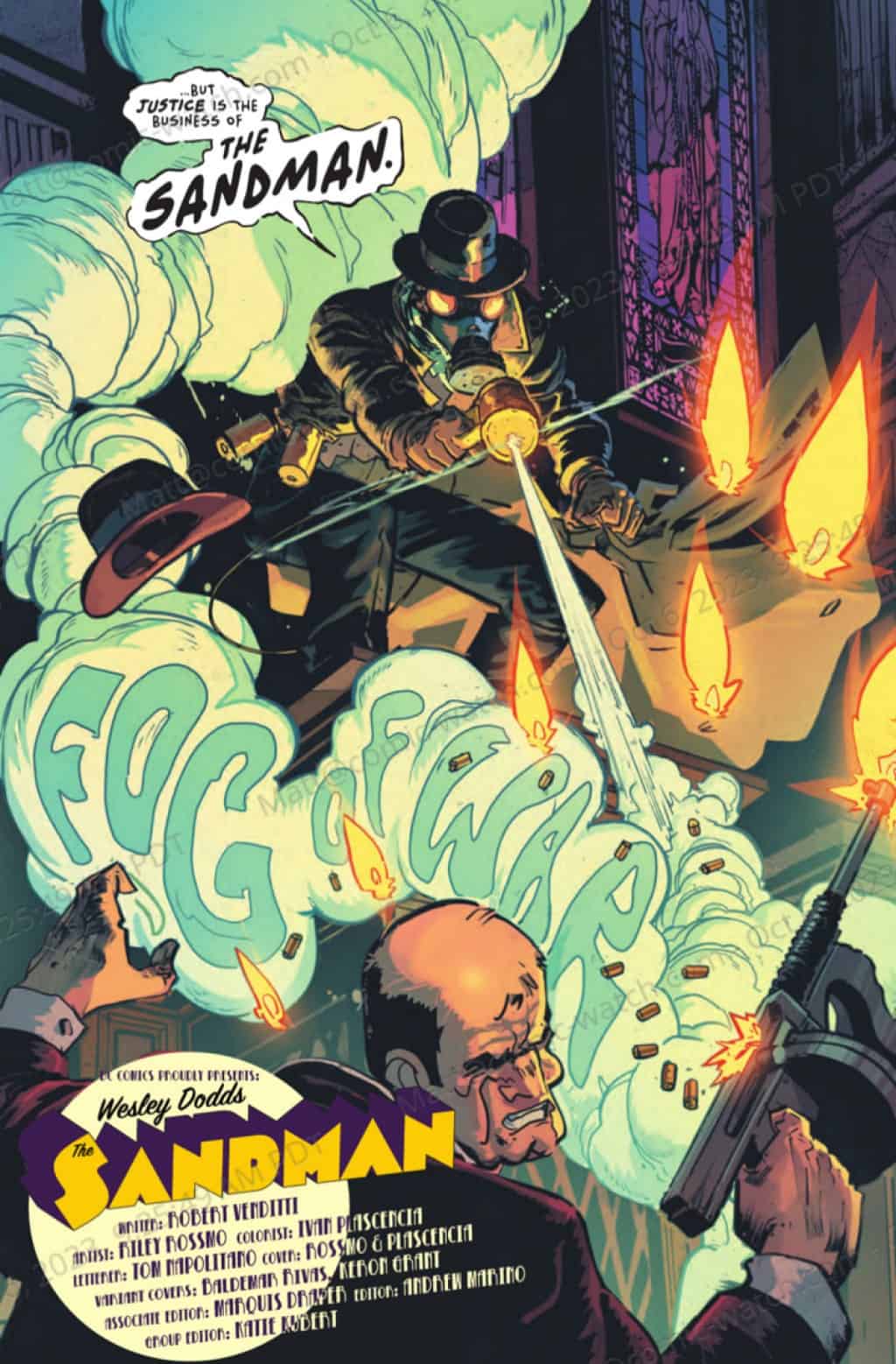Wesley Dodds: The Sandman #1

Recap
Wesley Dodds the first of several DC characters to bear the superhero name Sandman. Dressed in a business suit, trench coat, fedora, and World War I gas mask, the Sandman used a gun emitting a sleeping gas to sedate criminals in 1940s New York.
Review
Returning to the 1940s, where the jazz is swinging, the booze is flowing, and crime is on the prowl, our tale opens with Sandman, the secret identity of Wesley Dodds, taking down crime boss Robert Rossi after already handling his gang of henchmen at a Manhattan church in the dead of night. Sandman has bought justice once again with his ominous declaration to fight crime and gas gun spewing fumes of anesthesia everywhere, sedating everything in sight.


Immediately after trouncing the bad guy, we see the other trademark of Sandman as he ponders about his prophetic dreams for the near future. Dreams Wesley can barely understand of the heroic age to come, full of wonder, horrors, and sensations no one person could imagine. The following day, Wesley prepares for his meeting with the U.S military surrounded by his butler Humphreys and Love interest Dian. Even with help from his late father’s friend and associate, Mr. Vanderlyle, the interview does not go as expected. Demoralized from his failed business venture with the U.S. armed forces and despite his girlfriend, Dian’s endeavor to comfort his wounded pride with a night out on the town, Wesley can only think of saving lives, even if it is only one at a time as the Sandman.

Sandman is on the streets, away from the high society party, continuing to protect the innocent from muggers and reclaiming a portion of the night for the decent people of Manhattan. Ultimately, Wesley’s compassion takes him past fighting crime and onto a fire truck to help put the flames out of a burning house; to his surprise, the house is his own. Seasoned writer Robert Venditti begins his story with a clear idea of who Wesley Dodds is and carries it to the last page to show readers our hero of the hour is one of Mercy. Throughout this first issue, we see how Sandman, even when he uses force to win the fight, still shows mercy in all he does, from the use of his secret sleeping gas formula on crime to the sorrow and remorse he carries for the sacrifices he had to make to perfect said formula, to the disheartening failed attempt to sell his patented formula to the military in a noble effort to save lives on both sides of World War II. Venditti writes Wesley Dodds and his alter ego, The Sandman, with empathy most heroes have a hard time discovering, much less maintaining, after years of fighting crime. From beginning to end, Rossmo’s art is magnetic. Every page is thoughtful and perfectly frames Venditti’s words. From the jazz to the gas gun, Rossmo depicts the 40s with the vibrant urgency it demands. His clean lines and sharp expressions keep the action clear and never confusing. While always maintaining the fluid motion of sequential art comics, Rossmo pulls off some impressive snapshots, like the splash page introducing the Sandman.
The loosely bordered frame-ups focus on what he wants you to, reminding readers that you don’t need roll after roll of smaller panels to draw a great book. Ivan Plascencia’s colors are sumptuous and lively but never overbearing. He highlights the tone of every scene precisely. Tom Napolitano’s lettering work is unforgettable as he adapts the text of every character and sequence around the action, constantly adding to the image and never obscuring it.
Final Thoughts
Wesley Dodds: The Sandman is off to a beautiful start. The mystery The Sandman faces from the crime world of the 1940s and his shocking visions of the future makes this comic ever engrossing. Venditti's thoughtful portrayal of Dodds is both welcoming and unexpected while like a breath of fresh air Rossmo's layouts are gorgeous and a reminder of the inspiration many pencilers should have today.
Wesley Dodds: The Sandman #1: Before We Dream
- Writing - 10/1010/10
- Storyline - 10/1010/10
- Art - 10/1010/10
- Color - 10/1010/10
- Cover Art - 10/1010/10




